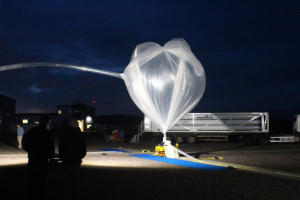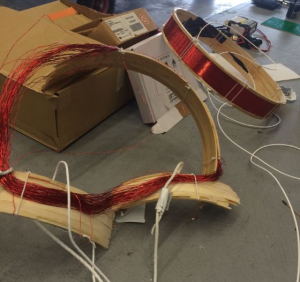It actually does take a rocket scientist to be a rocket scientist. Case in point: Professor of physics and electrical engineering at the UH Cullen College of Engineering Edgar Bering, whose business card really does say he’s a rocket scientist – and for good reason. He’s been working with NASA on sending things airborne for decades. Now he’s just back from Sweden where he and his students watched their payload launch in NASA’s fourth BARREL balloon campaign mission. Bering is joined on this quest by three colleagues, associate professors Jinghong Chen, electrical and computer engineering, and Craig Glennie and Debora Rodriques, both civil and environmental engineering.
BARREL stands for Balloon Array for Radiation-belt Relativistic Electron Losses and its purpose is to study the Van Allen belts, two huge radiation bands circling the globe. The radiation belts do most of their damage to spacecraft flying through them, which is why the space station’s orbit is selected to minimize its exposure to the radiation belts, but some of their particles are flung out into space.
“The particles in the radiation belts don’t stay there forever. They’re eventually lost to the atmosphere,” said Bering. That process of loss is called precipitation, like a rain of radiation from the upper atmosphere. To understand their atmospheric impact, NASA and company measure X-rays produced by electrons from the Van Allen belts.
"What we’re trying to do is understand how the radiation belts are created and filled and how and why the particles are lost,” said Bering. Lost particles can wreak havoc on satellite systems, knocking them out instantly.
“These killer electrons kill satellites,” said Bering. Getting a handle on the activity of the belts and precipitation will help predict whether satellites will be lost during a certain atmospheric event. “If you know that, you can turn the satellites off to prevent it,” he said.
Putting undergrads to work
And who better to work on such a heady project than the next generation of rocket scientists: Cullen College undergraduates taking part in NASA’s Undergraduate Student Instrument Project (USIP)? USIP provides real-life earth or space science flight project experience.
Samar Mathur, a junior in mechanical engineering, and Michael Greer, a senior in mechanical engineering, joined Bering’s very low frequency (VLF) team. “Our goal was to create the proper instrumentation, a VLF circuit, to gather the data, to read and process the waves,” Mathur said. They also built a complicated timecode circuit, called the IRIG-B, which keeps track of the exact time when data is actually gathered.
The work was intense, beginning in May for an August launch.
“Michael and I are mechanical engineers,” said Mathur. “We knew nothing about electricity coming into this, except basics, but nothing about circuitry.”
Greer agreed. “It was a lot of us sitting in the lab, changing out resistors, researching filters ourselves, banging our head against the wall – that’s when we would go talk to Dr. Bering,” he said.
That’s very much Dr. Bering’s style, said Mathur. “He’s taught us to learn trial by fire and then come to him when we’re stuck.”
“I lit fires with these students,” said Bering proudly. “But they did it and I’m incredibly proud.”
Christian Behrend, also a senior in mechanical engineering, worked on building the receiver that would actually listen to the VLF hiss in the atmosphere, made up of the electron precipitation.
“We repaired a VLF receiver that already existed and redesigned the antenna,” said Behrend.
Blastoff
The balloons, carrying the Cullen College payloads, were launched at the Esrange Space Center near Kiruna, Sweden, nearest to the Northern Lights, or Aurora Borealis. Since the aurora is the result of electrons colliding with the upper atmosphere it’s the best place to measure electron movement.
Takeoff launched the students into a giddy world of excitement. Said Behrend, “It’s really satisfying to make and put something on a payload and then watch it leave while you’re thinking, ‘That’s the thing that I did!’”
The entire group shared that sense of accomplishment.
Mathur said, “Honestly, when we were going to Sweden, we were in the airport and I was like, ‘Wait, what are we doing here?’”
Greer added a sense of uneasiness to his excitement. “It is a little bit scary watching everything we’ve worked on just float away, but it’s really a great feeling.”
The final analysis
Uncovering the results of the data collection comes next. Soon Bering and his students will open up the files to interpret the data collected. But one thing is already certain, according to Bering, and that’s the success of USIP.
“I am extremely proud of the entire USIP project. My colleagues and I have put together a program of instruction in science and engineering that is unmatched,” said Bering.
Interestingly, he actually radiates with excitement when he speaks of it.

